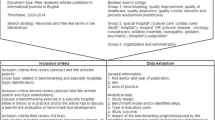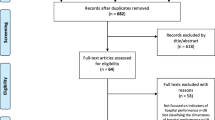Abstract
Operating room (OR) efficiency continues to be a high priority for hospitals. In this context the concept of benchmarking has gained increasing importance as a means to improve OR performance. The aim of this study was to investigate whether and how participation in a benchmarking and reporting program for surgical process data was associated with a change in OR efficiency, measured through raw utilization, turnover times, and first-case tardiness. The main analysis is based on panel data from 202 surgical departments in German hospitals, which were derived from the largest database for surgical process data in Germany. Panel regression modelling was applied. Results revealed no clear and univocal trend of participation in a benchmarking and reporting program for surgical process data. The largest trend was observed for first-case tardiness. In contrast to expectations, turnover times showed a generally increasing trend during participation. For raw utilization no clear and statistically significant trend could be evidenced. Subgroup analyses revealed differences in effects across different hospital types and department specialties. Participation in a benchmarking and reporting program and thus the availability of reliable, timely and detailed analysis tools to support the OR management seemed to be correlated especially with an increase in the timeliness of staff members regarding first-case starts. The increasing trend in turnover time revealed the absence of effective strategies to improve this aspect of OR efficiency in German hospitals and could have meaningful consequences for the medium- and long-run capacity planning in the OR.
Similar content being viewed by others
Notes
Namely: VOPM (Verband für OP-Management, Association for OR management), BDA/DGAI (Berufsverband Deutscher Anästhesisten, Professional Association of German Anaesthesiologists & Deutsche Gesellschaft für Anästhesiologie und Intensivmedizin, German Association of Anesthesiology and Intensive Care), BDC (Berufsverbad der Deutschen Chirurgen, Professional Association of German Surgeons).
Original observations at daily level which exceeded the lower and upper five percentiles were left out of monthly average calculations.
References
Baumgart, A., Schupfer, G., Welker, A., Bender, H.J., and Schleppers, A., Status quo and current trends of operating room management in Germany. Current opinion in anaesthesiology. 23(2):193–200, 2010. doi:https://doi.org/10.1097/ACO.0b013e328336b8b4.
Marjamaa, R., Vakkuri, A., and Kirvelä, O., Operating room management: Why, how and by whom? Acta Anaesth Scand. 52(5):596–600, 2008.
Bauer, M., Wäschle, R.M., Rüggeberg, J., Meyer, H.J., Taube, C., Diemer, M., and Schuster, M., The German perioperative procedural time glossary - a concerted recommendation of the German societies of anaesthesiology, surgery and operating room management. Anaesthesiol Intensivmed. 57:669–683, 2016.
Donham, R.T., Defining measurable OR-PR scheduling, efficiency, and utilization data elements: The Association of Anesthesia Clinical Directors procedural times glossary. Int Anesthesiol Clin. 36(1):15–30, 1998.
Marco, A.P., and Hart, S., Cross-industry benchmarking: Is it applicable to the operating room? Qual Manag Health Ca. 9(2):1–5, 2001.
Gordon, T., Paul, S., Lyles, A., and Fountain, J., Surgical unit time utilization review: Resource utilization and management implications. J Med Syst. 12(3):169–179, 1988.
Malapero, R.J., Gabriel, R.A., Gimlich, R., Ehrenfeld, J.M., Philip, B.K., Bates, D.W., and Urman, R.D., An anesthesia medication cost scorecard–concepts for individualized feedback. J Med Syst. 39(5):48, 2015.
Berry, M., Berry-Stolzle, T., and Schleppers, A., Operating room management and operating room productivity: The case of Germany. Health Care Manag Sc. 11(3):228–239, 2008.
van Veen-Berkx, E., Elkhuizen, S.G., Kalkman, C.J., Buhre, W.F., and Kazemier, G., Successful interventions to reduce first-case tardiness in Dutch university medical centers: Results of a nationwide operating room benchmark study. American journal of surgery. 207(6):949–959, 2014. doi:https://doi.org/10.1016/j.amjsurg.2013.09.025.
van Veen-Berkx E, Elkhuizen SG, van Logten S, Buhre WF, Kalkman CJ, Gooszen HG, Kazemier G (2015) Enhancement opportunities in operating room utilization; with a statistical appendix. The journal of surgical research 194 (1):43-51.e41-42. doi:https://doi.org/10.1016/j.jss.2014.10.044
Cardoen, B., Demeulemeester, E., and Beliën, J., Operating room planning and scheduling: A literature review. Eur J Oper Res. 201(3):921–932, 2010.
Chen, Y., Gabriel, R.A., Kodali, B.S., and Urman, R.D., Effect of anesthesia staffing ratio on first-case surgical start time. J Med Syst. 40(5):1–6, 2016.
Kodali, B.S., Kim, D., Bleday, R., Flanagan, H., and Urman, R.D., Successful strategies for the reduction of operating room turnover times in a tertiary care academic medical center. The Journal of surgical research. 187(2):403–411, 2014.
McDowell, J., Wu, A., Ehrenfeld, J.M., and Urman, R.D., Effect of the implementation of a new electronic health record system on surgical case turnover time. J Med Syst. 41(3):42, 2017.
Porta, C.R., Foster, A., Causey, M.W., Cordier, P., Ozbirn, R., Bolt, S., Allison, D., and Rush, R., Operating room efficiency improvement after implementation of a postoperative team assessment. The Journal of surgical research. 180(1):15–20, 2013.
Van Houdenhoven, M., Hans, E.W., Klein, J., Wullink, G., and Kazemier, G., A norm utilisation for scarce hospital resources: Evidence from operating rooms in a Dutch university hospital. J Med Syst. 31(4):231–236, 2007.
Schuster, M., Bertheau, S., Taube, C., Bialas, E., and Bauer, M., Overlapping anaesthesia induction and perioperative turnover times an analysis of incidences and time expenditure in German hospitals based on 54,750 turnovers in 43 OR suites reporting to the benchmark programme of the BDA/BDC and VOPM. ANASTHESIOLOGIE & INTENSIVMEDIZIN. 55:654–661, 2014.
Schuster, M., Pezzella, M., Taube, C., and Bialas, E., Diemer M. Bauer M Verzögerungen beim morgendlichen Operationsbeginn.
Gabriel, R.A., Gimlich, R., Ehrenfeld, J.M., and Urman, R.D., Operating room metrics score card—Creating a prototype for individualized feedback. Journal of medical systems. 38(11):144, 2014.
Gabriel, R.A., Wu, A., Huang, C.-C., Dutton, R.P., and Urman, R.D., National incidences and predictors of inefficiencies in perioperative care. Journal of clinical anesthesia. 31:238–246, 2016.
Wooldridge, J.M., Econometric analysis of cross section and panel data. MIT press, 2010.
Luedi, M.M., Kauf, P., Mulks, L., Wieferich, K., Schiffer, R., and Doll, D., Implications of patient age and ASA physical status for operating room management decisions. Anesthesia and analgesia. 122(4):1169–1177, 2016. doi:https://doi.org/10.1213/ane.0000000000001187.
Overdyk, F.J., Harvey, S.C., Fishman, R.L., and Shippey, F., Successful strategies for improving operating room efficiency at academic institutions. Anesthesia and analgesia. 86(4):896–906, 1998.
Panni, M., Shah, S., Chavarro, C., Rawl, M., Wojnarwsky, P., and Panni, J., Improving operating room first start efficiency–value of both checklist and a pre-operative facilitator. Acta Anaesth Scand. 57(9):1118–1123, 2013.
Truong, A., Tessler, M.J., Kleiman, S.J., and Bensimon, M., Late operating room starts: Experience with an education trial. Canadian journal of anaesthesia = Journal canadien d'anesthesie. 43(12):1233–1236, 1996. doi:https://doi.org/10.1007/bf03013431.
Wachtel, R.E., and Dexter, F., Influence of the operating room schedule on tardiness from scheduled start times. Anesthesia and analgesia. 108(6):1889–1901, 2009.
Schuster, M., Kotjan, T., Fiege, M., and Goetz, A., Influence of resident training on anaesthesia induction times. Brit J Anaesth. 101(5):640–647, 2008.
Bender, H., Waschke, K., and Schleppers, A., Are turnover times a measure of effective operating room management? Anaesthesiol Intensivmed. 45(9):529–535, 2004.
Grote, R., Sydow, K., Radke, J., Leuchtmann, D., Menzel, M., Walleneit, A., and Hudde, T., More operations per day through reducing turnover times: Fact or fiction? Anaesthesiol Intensivmed. 52, 2011.
Grote, R., Sydow, K., Menzel, M., Hunziker, S., and Schüpfer, G., Überlappende Einleitung. Der Anaesthesist. 58(10):1045–1047, 2009.
Al-Benna, S., The impact of late-starts and overruns on theatre utilisation rates. J Perioper Pract. 22(6):197–199, 2012.
Dexter, F., Abouleish, A.E., Epstein, R.H., Whitten, C.W., and Lubarsky, D.A., Use of operating room information system data to predict the impact of reducing turnover times on staffing costs. Anesthesia and analgesia. 97(4):1119–1126, 2003.
Faiz, O., Tekkis, P., McGuire, A., Papagrigoriadis, S., Rennie, J., and Leather, A., Is theatre utilization a valid performance indicator for NHS operating theatres? BMC health services research. 8:28, 2008. doi:https://doi.org/10.1186/1472-6963-8-28.
Author information
Authors and Affiliations
Corresponding author
Ethics declarations
Conflict of Interest
Dr. Bialas is CEO of the external IT provider which gathers the data and administers the platform. He contributed with important intellectual content for the formulation of the research question and the interpretation of the results. He did not have any influence in the study design or analysis methodology.
Informed Consent/IRB Approval
Does not apply. All hospitals delivering data for the benchmarking program agreed to the use of anonymous data for scientific purposes. These were accessed by SP in the period between October 2015 and March 2016 in order to carry on the analysis.
Additional information
This article is part of the Topical Collection on Education & Training
Rights and permissions
About this article
Cite this article
Pedron, S., Winter, V., Oppel, EM. et al. Operating Room Efficiency before and after Entrance in a Benchmarking Program for Surgical Process Data. J Med Syst 41, 151 (2017). https://doi.org/10.1007/s10916-017-0798-0
Received:
Accepted:
Published:
DOI: https://doi.org/10.1007/s10916-017-0798-0




